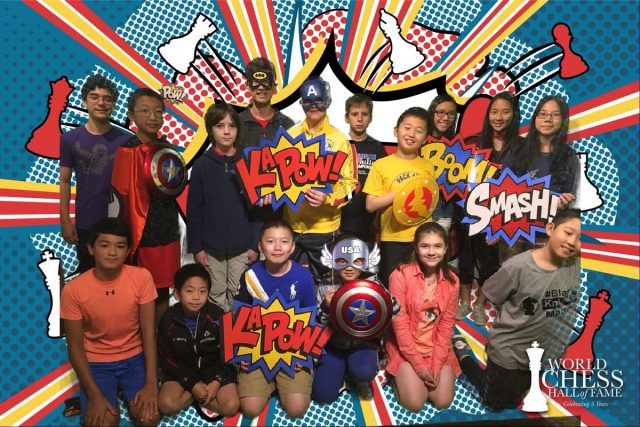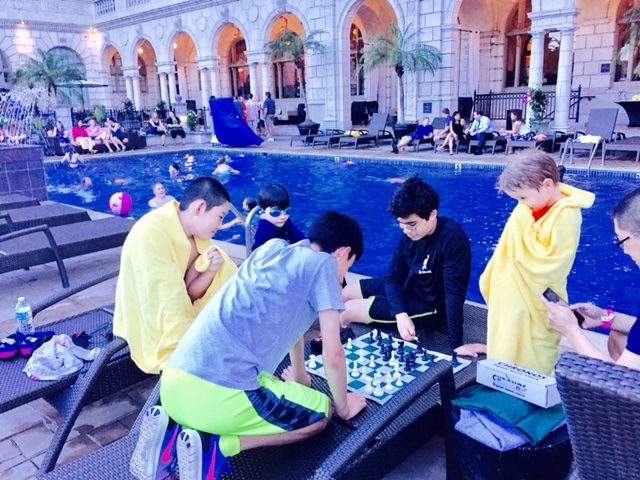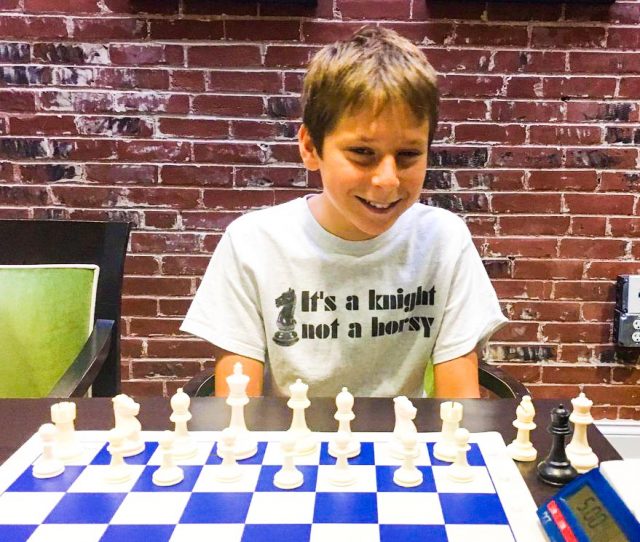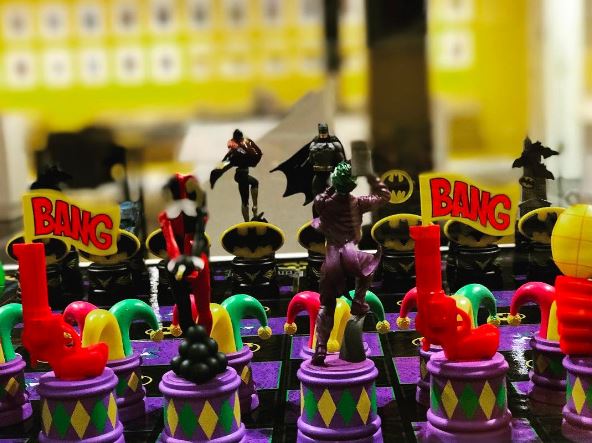
Back Row: Akira Nakada (that’s me), Andy Huang, Gus Huston, Wesley Wang, Aydin Turgut, Robert Shlyakhtenko, Eric Li, Emily Nguyen, Annie Wang, Evelyn Zhu Front Row: Vincent Baker, Jason Wang, Logan Wu, Luke Ye, Nastassja Matus, Eddy Tian
My year was filled with intensive schoolwork and a packed schedule so it felt good to be able to focus 100% on improving my chess. Receiving the invitation to come back to Saint Louis for my third U.S Chess School camp was a welcome end to a busy year. Remembering last year’s U.S Chess School and the learning experience that it was, I instantly started packing my bags for The Gateway City. IM Armen Ambartsoumian was our coach with guest lecturer Greg Shahade, and Aviv, along with organizing the camp, provided an intuition test. Coming to Saint Louis with my mom and little brother, Johji, it was nice to see all these familiar faces again.
Contrary to any other camp I have been to, this camp focused on some of the lesser taught yet very critical aspects of chess: Material Sacrifice and how to approach opening preparation. When I say material sacrifice, I don’t mean a sacrifice for immediate obvious compensation such as for a mating attack or for crushing initiative, I am talking more about long-term sacrifices. When you look at the top players’ games, many of them are decided by a difference in the evaluation of a sacrifice by the players. One example that we were shown during the lectures was this game: Carlsen-Aronian in which the black player sacrificed a pawn for compensation.
[pgn]
[Event "EU-chT 20th"]
[Site "Reykjavik"]
[Date "2015.11.15"]
[White "Carlsen, Magnus"]
[Black "Aronian, Levon"]
[Result "0-1"]
[ECO "C65"]
[WhiteElo "2850"]
[BlackElo "2781"]
[Annotator "anakada_17"]
[PlyCount "90"]
[EventDate "2015.11.13"]
[EventType "team-swiss"]
[EventRounds "9"]
[EventCountry "ISL"]
[Source "Chessbase"]
[SourceDate "2015.11.27"]
[WhiteTeam "Norway"]
[BlackTeam "Armenia"]
[WhiteTeamCountry "NOR"]
[BlackTeamCountry "ARM"]
1. e4 e5 2. Nf3 Nc6 3. Bb5 Nf6 4. d3 Bc5 5. O-O Nd4 6. Nxd4 Bxd4 7. c3 Bb6 8.
Na3 c6 9. Ba4 d6 10. Bb3 a5 {Trying to keep the bishop on the a7-g1 diagonal}
11. Nc4 Ba7 12. a4 O-O $5 (12... h6 {Would stop Bg5 and save the a pawn, but
Aronian had something else in mind}) 13. Bg5 h6 14. Bxf6 (14. Bh4 g5 15. Bg3
Bg4 16. Qc2 Nh5 17. Ne3 Bxe3 18. fxe3 Nxg3 19. hxg3 Kg7 20. Rf2 f6 $11) 14...
Qxf6 15. Nxa5 d5 $1 {The point of his combination. While Carlsen is content
with taking pawns, Aronian feels that black already has a slight edge because
of his piece placement and center. Black later went on to win the game.} 16.
Bc2 dxe4 17. dxe4 Rd8 18. Qe1 Qg5 19. Kh1 Rd2 20. Bd1 Be6 21. b4 Rad8 22. Nxb7
Bc4 23. Nxd8 Bxf1 24. Qxf1 Rxf2 25. Qg1 Ra2 26. Rxa2 Bxg1 27. Kxg1 Qc1 28. Kf2
Qxd1 29. Nxc6 Qb3 30. Rd2 Qxc3 31. Rd6 Qb2+ 32. Ke3 Qa3+ 33. Kf2 Qxa4 34. Nxe5
Qc2+ 35. Kf3 f5 36. Rd3 fxe4+ 37. Kxe4 Qxg2+ 38. Nf3 Qg4+ 39. Ke3 g5 40. Kf2
Qf5 41. Rd8+ Kg7 42. Kg2 g4 43. Nd2 Qe6 44. Nf1 Qc6+ 45. Kf2 Qb6+ 0-1[/pgn]
Here are a few more examples from the camp:
[pgn]
[Event "URS-CupT"]
[Site "Ordzhonikidze"]
[Date "1978.??.??"]
[Round "?"]
[White "Kapengut, Albert Z"]
[Black "Dvoretzky, Mark"]
[Result "0-1"]
[ECO "B45"]
[WhiteElo "2465"]
[BlackElo "2525"]
[Annotator "anakada_17"]
[PlyCount "91"]
[EventDate "1978.05.??"]
[EventType "team"]
[EventRounds "7"]
[EventCountry "URS"]
[Source "ChessBase"]
[SourceDate "2000.11.22"]
1. e4 c5 2. Nf3 e6 3. d4 cxd4 4. Nxd4 Nf6 5. Nc3 Nc6 6. Nxc6 bxc6 7. e5 Nd5 8.
Ne4 Qc7 9. f4 Qb6 10. Bd3 Ba6 11. a3 f5 {An old theoretical line} 12. exf6 Nxf6
13. Nxf6+ gxf6 14. Qh5+ Kd8 15. Bd2 {What should black do here?} Bxd3 $1 {
A very good practical decision. While the computer evaluates this position
around +1.8, it is very hard to win for white and when our group played this
position against each other, the results were around 50% for white and black.}
16. Ba5 Bxc2 17. Rf1 f5 18. Bxb6+ axb6 19. Rf3 Kc7 20. Rg3 Ra4 21. Qf3 Rc4 22.
Rc1 $6 {and black later went on to win the game} (22. b3 $1 Be4 23. Qe2 Rc2 24.
Qa6 {and white should be winning, the key to winning is creating counterplay
against the king}) 22... Bd6 23. Qe2 Re4 24. Rxc2 Bxf4 25. Rg7 Bxh2 26. Qxe4
fxe4 27. Rd2 Bd6 28. Rd4 c5 29. Rxe4 Kc6 30. b3 h5 31. Rh4 b5 32. Ke2 Be5 33.
Rg5 Bd4 34. Rhxh5 Ra8 35. Rh3 Rxa3 36. Rg8 e5 37. g4 Ra2+ 38. Kf3 Rf2+ 39. Kg3
Rb2 40. g5 Rxb3+ 41. Kg4 Rxh3 42. Kxh3 Kd5 43. g6 e4 44. Rb8 b4 45. Kg4 Kc4 46.
Kf4 0-1[/pgn]
In my opinion, the difficulty of evaluating a sacrifice, especially when we don’t see a way to win back the material, stems in part from the fact that there is a misguided focus on hoarding material. Also, long-term sacrifices are not taught by coaches very often (if at all) when their students are kids. This means that long-term sacrifices are not included in the intuition (subconscious information) of the chess player, making it harder to pay attention to them during a game. I am happy to have learned this concept at the U.S Chess School as it is an important stepping stone for players at our level.
As your rating climbs higher and higher, you find that good calculation and strong positional play are simply not enough to compete in this computer filled world. Many people now memorize opening lines 40 moves deep on the computer and prepare devious traps that are almost impossible to spot without adequate knowledge of the position. So, while the opening may not be the most important part of the game, it is still a crucial part of the game for any ambitious player and it was the second major topic of this particular U.S Chess School.
The main advice Armen had to give on this subject was to be an active learner with openings, a concept I have read before in several books but never really paid any attention to. The essence of active learning is that you should work on your openings without being mesmerized by the engines first lines. You must analyze the different lines on your own, finding the strongest ideas for both sides through your own work. The occasional guidance of the computer is fine, but you have to question the computer's lines: why does it say this position is better for white? What if I just take a pawn here? What is the winning plan? This questioning and self-analysis is key because you can remember your own analysis better than a computer’s, and you get a better sense of the overall type of position. One example that Armen gave us was of this very talented player who went to World Youth a while back. When preparing for a game, he would recite 30 move lines, but then in his game, his opponent deviated and played a logical, but not theoretical move early on: he had no idea what to do. When questioning while analyzing, you begin to understand the nuances and ideas of the position and why the most popular moves are played.
One opening that I think captures the importance of active learning is the King's Indian, especially in some of the main lines.
[pgn]
[Event "Marshall G60"]
[Site "?"]
[Date "2015.10.07"]
[Round "?"]
[White "KID kh1 prep"]
[Black "?"]
[Result "*"]
[ECO "E99"]
[Annotator "Nakada,Akira"]
[PlyCount "42"]
[SourceDate "2015.04.12"]
1. d4 Nf6 (1... d5 2. c4 e6 3. Nc3 c6 4. e3) 2. c4 g6 3. Nc3 Bg7 (3... d5 4.
Bf4) 4. e4 O-O 5. Nf3 d6 6. Be2 e5 7. O-O Nc6 (7... Nbd7 8. Be3 (8. d5 b6 (8...
c5) (8... Nc5 9. Qc2 a5 10. Be3 (10. b3) 10... b6 11. b3 Nh5 12. g3 f5 13. exf5
Bxf5 14. Qd2 {we are lucky that the pawn is still on a2 because if it is not,
then b3 will be hanging}) (8... c6) (8... Qe7) 9. Be3 $6 Nc5 10. Nd2 a5 11. a3
a4 12. Bxc5 bxc5 (12... dxc5) 13. Nxa4 Bd7 14. Nc3) 8... Ng4 (8... Re8 9. d5
Nh5 10. g3 f5 (10... Bf8 11. b4 Ng7 (11... a5) 12. a4 (12. a3 f5 13. c5 dxc5
14. Bg5 (14. Qb3 Bd6 (14... a6 15. d6+ Kh8 (15... Ne6 16. exf5 gxf5 17. Bg5 Nf6
18. dxc7 Qxc7 19. Bxf6) 16. Ng5) 15. Bg5 Nf6) 14... Nf6)) 11. exf5 gxf5 12. Nh4
Nf4 13. Nxf5 Nxe2+ 14. Qxe2) (8... Nh5) (8... c6 9. d5 c5 10. g3) 9. Bg5 f6 10.
Bc1 (10. Bd2 exd4 (10... Nh6 11. c5 (11. Be3 Ng4) (11. h3) (11. Qc2 f5 12. Bg5)
11... exd4 12. Nxd4 Nxc5 13. b4 Na6 14. Bxa6 bxa6 15. Nd5 f5 (15... Bd7 16. Qc1
) 16. Nc6 Qd7 17. Nce7+ (17. Nde7+) 17... Kh8 18. Rc1) 11. Nxd4) 10... Nh6 11.
dxe5) (7... Na6 8. d5 Ne8 (8... Nh5 9. g3 Nf6)) 8. d5 Ne7 9. Ne1 (9. b4 Ne8 10.
c5 f5 11. Nd2 Nf6 12. f3 f4 13. Nc4 g5 14. a4 Ng6 15. Ba3 Rf7 16. b5 dxc5 17.
Bxc5 h5 18. a5 g4 19. b6 g3 20. Kh1 Bf8 21. d6 axb6 22. Bg1 gxh2 23. Bf2 bxa5
24. dxc7 Qxd1 25. Rfxd1 Rxc7 26. Nb6 Rxc3 27. Nxa8 Rc2 28. Ra2 Rxa2 29. Bc4+
Kg7 30. Bxa2 b5 31. Nc7) 9... Nd7 (9... Ne8 10. Be3 f5 11. f3 f4 12. Bf2 g5 13.
c5 (13. Nd3 Nf6 (13... Rf6 14. c5 h5 15. Kh1 (15. cxd6) (15. Qb3) 15... Rg6 16.
Rg1 Bf8 17. Rc1 Rg7 (17... Bg7) 18. cxd6 cxd6 19. Nb5 Ng6 20. Nxa7 Bd7 21. a4
Nf6 (21... g4 22. g3 fxg3) 22. g3 fxg3 23. Rxg3 g4 24. Rg2 h4 25. Nb5 g3 26.
hxg3 hxg3 27. Bxg3 Bh3 (27... Nh5 28. Bh2 Bh3 (28... Ngf4) (28... Qf6) 29. Rg1
Qf6 (29... Nf6) 30. Bf1 Bd7 31. Rc7 Bxb5 32. Rxg7+ Bxg7 33. axb5 Rf8 34. Be2
Kf7 35. Qc1 Nhf4 36. Nxf4 Nxf4 37. Qc7+ Kg8 38. Bf1 Kh8 39. Qd7 Rg8 40. Rg3 Rf8
41. Qxb7 Rf7 42. Qc8+ Bf8 43. b6 (43. Qg4 Rg7 44. Qf5 Qxf5 45. exf5 Rc7 46. f6
Nxd5 47. f7) 43... Rh7 44. b7 Qh6 45. Rh3 (45. Bh3 Nxh3 (45... Rxb7) 46. Rxh3))
)) 13... Rf6 14. Nd3 Rg6 15. Kh1 Nf6 16. Rg1 (16. Rc1 g4 17. fxg4) 16... g4 17.
g3 fxg3 18. Bxg3 gxf3 (18... h5 19. f4) 19. Bxf3) 10. Be3 f5 11. f3 f4 12. Bf2
g5 13. Nd3 (13. Rc1 Ng6 14. c5 $5) (13. b4 Nf6 14. c5 Ng6) 13... Ng6 (13... Nf6
14. c5 Ng6 15. Rc1 Rf7 16. Kh1 Bf8 17. Rg1 h5 18. g3 (18. cxd6 cxd6 19. g3 fxg3
20. Rxg3 Bh6 21. Be3 h4 22. Rxg5 Bxg5 23. Bxg5 Qf8) 18... g4) 14. c5 Nf6 (14...
h5 15. cxd6 cxd6 16. Nb5 Nf6 17. Nxa7 g4 18. Nxc8) 15. Rc1 Rf7 (15... h5 16.
cxd6 (16. Qb3 g4 17. cxd6 cxd6 18. Nb5 g3 (18... Ne8 19. Nxa7 (19. Kh1 Qg5 (
19... g3 20. hxg3 fxg3) 20. Nxa7 g3 (20... Bd7 21. Ne1 g3 22. Bg1 gxh2 23. Bxh2
h4 (23... Nh4))) 19... g3 20. hxg3 fxg3 21. Bxg3 Rxa7) 19. hxg3 fxg3 20. Bxg3)
16... cxd6 17. Nb5 Rf7 18. Nxa7 (18. Qb3 g4 19. Nxa7 g3 20. Bb6 Qe8 21. Rxc8 (
21. Nb5)) 18... Bd7 (18... g4) 19. Qb3 g4 20. Qb6 (20. Bb6) 20... Qf8 21. Nb5
g3 22. hxg3 fxg3 23. Bxg3 h4 24. Bf2 Nh5 25. Rfe1 (25. Nc7 Ngf4 26. Nxf4 Nxf4
27. Bc4 (27. Bb5)) 25... Bh6 26. Qxd6 Qg7 27. Nc7 Ngf4 28. Bf1 Nxd3 29. Bxh4
Nxe1 30. Rxe1 Rxf3 31. Nxa8 Nf4 (31... Rf4) 32. g3 Rxg3+ 33. Kf2 Rg2+) 16. Kh1
Bf8 (16... h5 17. cxd6 (17. b4 g4 18. Qa4) (17. Nb5 g4 18. cxd6 cxd6 19. Nxa7
Bd7 20. Qb3 g3 21. hxg3 fxg3 22. Bxg3) (17. a4 g4 18. cxd6 cxd6 19. h4) (17.
Rg1 g4 18. g3 fxg3) 17... cxd6 18. Rg1 (18. Nb5 {Black needs the h5 square for
his pieces, so with his pawn on h5, he cannot create a decisive attack.} a6 (
18... g4 19. Qc2 (19. g3) (19. Qb3 a6 20. Nc7 Rxc7 21. Bb6 Ne8 22. Rxc7 (22.
Bxc7 Nxc7) 22... Nxc7 23. Rc1 Qg5 24. Bxc7) (19. Nxa7 Bd7 (19... g3 20. Rxc8 (
20. Nxc8) 20... Rxc8 21. Nxc8 gxf2 (21... Qxc8 22. hxg3) 22. Na7) 20. Qb3 g3
21. Bb6 Qe7 22. Rc7 Ng4 (22... Ne8 23. Rxb7 Qh4 24. Bg1) 23. fxg4 Qh4 24. Bg1
Rxa7 25. gxh5 Nf8 26. Qb6 Bh6 27. Qxa7 f3 28. Bxf3 gxh2) 19... Ne8 20. Nxa7 Bd7
21. Qb3 g3 22. Bg1 gxh2 (22... h4 23. h3) 23. Bf2 h4 24. Kxh2 h3 25. gxh3 Qg5
26. Rg1 Qh5 27. Bf1) 19. Nc3 (19. Nc7 Rxc7 20. Bb6 Rxc1 21. Bxd8 Rxd1 22. Bxd1)
19... g4 (19... Bd7 20. Na4 Rc8 21. Nb6 Rxc1 22. Qxc1 g4 23. Nxd7 Qxd7 (23...
Rxd7 24. Qd2) 24. Qc4 g3 (24... Bh6) 25. hxg3 (25. Bb6 gxh2 26. Rc1 Rf8) 25...
fxg3 26. Bxg3 h4 27. Bh2 Nh5) 20. Na4 g3 21. Nb6 Rb8 (21... gxf2 22. Nxa8) 22.
Bg1 (22. Rxc8 Rxc8 23. Nxc8 gxf2) (22. Qc2 Bd7 (22... gxf2 23. Qxc8 Rxc8 (23...
Rf8 24. Qxd8 Rfxd8 25. Nxf2) 24. Rxc8 Qxc8 25. Nxc8) 23. Nxd7 Qxd7 24. Ba7 Rbf8
(24... h4 25. Bxb8 h3) 25. Bb6 h4 (25... gxh2 26. Qc7) 26. h3 (26. Qc7 h3 27.
Qxd7 Nxd7 28. Bc7) 26... Nh7 (26... Re7 27. Qc7 Qxc7 28. Bxc7) 27. Qc7 Qb5 28.
a4 (28. Nxe5 Qxe2) 28... Qb3 29. Rc3 Rxc7 (29... Qxa4 30. Qxd6 Rf6) 30. Rxb3
Rc2 31. Re1 Rfc8 32. Ba5) 22... gxh2 23. Bf2 h4 24. Qc2 Bd7 25. Qc7 Qf8 26. Nc4
) 18... g4 19. g3 gxf3 (19... fxg3 20. Rxg3 Bh6 (20... h4 21. Rg1 g3 22. hxg3
Nh5 23. g4 Nhf4 24. Nxf4 Nxf4 25. Be3)) 20. Bxf3 Ng4 21. Qe2 (21. Be1) 21...
Bh6 (21... fxg3 22. Bxg3 (22. Rxg3) 22... Bh6 23. Rcf1) (21... Nxf2+ 22. Qxf2
Bg4 23. Qe2 Qd7 24. gxf4 Nxf4 25. Nxf4 Rxf4 26. Bxg4 hxg4 27. Nb5 Bh6 28. Rc7
Qd8 29. Rxg4+)) 17. cxd6 (17. b4 h5 18. Nb2 (18. Rg1 g4 19. a4 (19. g3) 19...
g3) 18... g4 19. Nc4 g3) (17. a4 h5 18. g3 (18. Rg1 g4 19. cxd6 cxd6 20. b3 g3)
18... fxg3 19. hxg3) 17... cxd6 18. Rg1 (18. Qd2 g4 19. g3) 18... h5 19. g3 (
19. Qd2 g4 20. g3 gxf3 21. Bxf3 Ng4 (21... Bg4 22. Bxg4 Nxg4)) 19... g4 (19...
fxg3 20. Rxg3 g4 (20... Bh6 21. Be3 h4 22. Rxg5 Bxg5 23. Bxg5 Qf8 24. Qd2 (24.
Qg1 Kh7 25. Be3 Rg7) 24... Nh5) 21. Qd2 h4 (21... Nf4 22. Nxf4 Bh6 23. Rg2 (23.
fxg4 Bxf4 24. gxh5+ Bxg3 (24... Bg4 25. Be3 Bxg3 26. Rg1 Bxh5 27. Rxg3+ Kh8)
25. Rg1 Rg7 26. Rxg3 (26. Bxg3)) 23... Bxf4 24. Be3 Bxe3 25. Qxe3 Rg7 26. Rf1 (
26. Bf1)) 22. Rgg1 Nh5 23. fxg4 Nhf4 24. Be3 Bg7) 20. Qd2 (20. gxf4 exf4 21.
Nb5 (21. Bd4 Bg7 22. Bxf6 Qxf6 23. fxg4)) 20... gxf3 21. Bxf3 Bg4 (21... Ng4) *[/pgn]
In this sharp variation, white goes for an attack on the queenside while black tries to checkmate the white king. Here the main line continues with Rf7 and then later Bf8 Rg7 with h5 g4, but no one really plays this way. There are so many different viable attacking continuations and move orders that it is impossible to memorize all of them. That is why it is important to get a feel for the position and the viable options that you have, so you can apply your knowledge to any continuation, not just the main line.
The camp is not only intensive chess though. We are also given many opportunities to have fun, relax, and enjoy. In addition to the breaks in between lectures, we were also able to continue the tradition and play the blitz and bullet tournaments, one of the most exciting parts of camp. Since I only made it past the first round last year and the year before in the blitz, I was aiming for something higher, but sadly my hopes came to an end in the second round. I was playing Wesley Wang and got a decent position out of the opening, but later thought I had his rook trapped and made a ridiculous blunder.
https://www.youtube.com/watch?v=2m3aliDUVzc
After a couple crazy games with queen blunders and spectacular comebacks in time pressure, it came down to the final four: Annie Wang vs Andy Huang and Wesley vs Aydin (the classic duel). Andy won in a relatively quiet Slav while Aydin gained an advantage as black but failed to win the game.
https://www.youtube.com/watch?v=qA31Nlgv9fE
There could not have been more tension in the room, it was the tiebreaker of the classic duel Aydin vs Wesley and with only 1 minute, I figured there was sure to be some exciting action and I couldn’t have been more right. There must have been around 15 huge blunders in that game, Wesley hanging a bishop on a7 set the tone. The position looked something like this:
[pgn]
[Event "?"]
[Site "?"]
[Date "2017.07.13"]
[Round "?"]
[White "Aydin"]
[Black "Wesley"]
[Result "1-0"]
[Annotator "anakada_17"]
[SetUp "1"]
[FEN "r3r1k1/bbp1qpp1/p2p1n1p/1p2p3/4P3/2PPBN1P/PPB1QPP1/R4RK1 b - - 0 1"]
[PlyCount "2"]
[SourceDate "2015.04.12"]
1... Rad8 $4 2. Bxa7 1-0[/pgn]
Here Wesley played Ra8-d8???
Then after playing c5, Wesley managed to trap the bishop and win it back on a7. For a few seconds everything seemed to be going normal for high-level bullet, both players making useless but not losing moves, when Wesley then blundered his other bishop! This was generously followed by a rook, which, Aydin, being a gentleman, decided not to accept, then found hanging a couple moves later. In the end Aydin won the game and the final game was Andy vs Aydin. The game was a great technical game from Andy’s side and he won in an endgame after a couple blunders from Aydin.
Subscribe to Greg Shahade's YouTube channel to see more US Chess School videos.
All in all, it was a great experience for all of us.
Next on the fun side of the agenda was the intuition test. This year Aviv made us a particularly “easy” test, or so he said. While intuition tests are usually one move per puzzle, Aviv decided to switch it up and made some of the puzzles a series of moves. This new rule caused some complaints and controversy, with the opinion that some of the problems were not testing your intuition, but were testing your ability to calculate variations and that the extra moves were not necessary. Personally, I thought the test was great!
It is not every day that you see an entire museum dedicated to chess,
at the World Chess Hall of Fame. Every year I love to come back and see the installations and beautiful artwork that people have done because they were connected to chess in some way. We had a blast playing with the action hero inspired boards, and hopefully some of the of the pieces’/characters’ wide range of powers will rub off on those of us who ventured forth to conquer.
Later that day, after visiting the WCHOF, some of us decided to cool off by the pool and play some blitz. US Chess camp is the best place for 24/7 chess.
 The water was just right. Blitz was pretty great too!
The water was just right. Blitz was pretty great too!
As the US Chess camp was coming to an end, we realized that we still had to fit in the bullet tournament. After all, US Chess Camp would not be US Chess camp without the tournaments! Everyone was excited for the bullet tournament and began to strategize about getting positions where they could shuffle their pieces a lot. As the tournament progressed, it seemed as if it would be yet another case of the Aydin-Wesley showdown, but that was not to be! This time Jason Wang defeated blitz winner Andy and Aydin as well, while Robert pulled off some major upsets of his own, beating Annie, Wesley, and Jason in an intense final match! What an amazing run.

Robert smiling after his bullet victory!
Finally, after 5 amazing days of meeting new people, making new friends, and learning invaluable information, it was time to go home. We had one last bughouse run before campers started leaving for the airport, which is always the saddest time for me. I asked my mom if I could stay in St. Louis another day to soak in more of the chess environment there, but I had to go, and on the plane home, although I was not as excited as on my journey to St. Louis, I had such a feeling of joy and accomplishment that only the US Chess School brings. I want to thank Aviv, Greg, Armen, The St. Louis Chess Center, our main sponsor Dr. Jim Roberts, the other wonderful sponsors, and all of my fellow campers for giving me an opportunity of a lifetime, multiple times.
Find out more about the US Chess School on their website, facebook and instagram.  Back Row: Akira Nakada (that’s me), Andy Huang, Gus Huston, Wesley Wang, Aydin Turgut, Robert Shlyakhtenko, Eric Li, Emily Nguyen, Annie Wang, Evelyn Zhu Front Row: Vincent Baker, Jason Wang, Logan Wu, Luke Ye, Nastassja Matus, Eddy Tian
Back Row: Akira Nakada (that’s me), Andy Huang, Gus Huston, Wesley Wang, Aydin Turgut, Robert Shlyakhtenko, Eric Li, Emily Nguyen, Annie Wang, Evelyn Zhu Front Row: Vincent Baker, Jason Wang, Logan Wu, Luke Ye, Nastassja Matus, Eddy Tian









